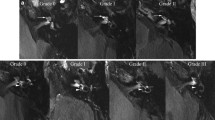Abstract
Early recognition of Cerebellopontine angle tumours reduces the morbidity and mortality of these patients. With this view 112 patients were studied using clinical audiovestibular and neuroradiological studies. It is observed that using X-rays in Towne’s, Anterio-posterior, Stenver’s views; Audiometry studying pure tone, speech, tone decay, recruitment; studying Nystagmus, spontaneous and induced with or without fixation, caloric tests; contrast X-ray studies such as carotid angiography and conray ventriculography, it is neither possible to detect the tumour still confined to the internal meatus, nor detect their exact nature. Therefore cases amenable to transtemporal extra labyrinthine approach can’t be detected with this battery of tests.
However, tumours of the 2nd stage and other advanced stages could be detected where the translabyrinthinine or posterior fossa approach might be tried.
Similar content being viewed by others
References
Ambrose, J. and Hounsfield, G. (1973): Computerized transverse axial tomography.British Journal of Radiology,46: 148.
Cawthorne, T. (1946): “Vestibular injuries”Proceedings of Royal Society of Medicine 39: 270.
Crowe, S. J. and Hardy, M. (1936): Early asymptomatic acoustic tumours,Archives of Surgery,32: 292.
Fisch, U. (1970): Transtemporal surgery of internal auditory canal, Advances in Oto-rhino-laryngology, Ed. Reudi, L., Vol. 17, Basel, Karger.
Hodes, P. J., Pendergrass, E. P., Young, B. R. (1949): 8th nerve tumours,Radiology,53: 633.
Lloyd, G. A. S. (1973): Recent advances in oto-rhinolaryngology, Chapter 25, Edited by Ransome J. Holden, H. and Bull, T. R. Edinburgh and London, Churchill Livingstone.
Mishra, S. C., Sharma, A. and Sardana, S. K. (1976): Significance of vestibular tests in idiopathic facial paralysis,Indian Journal of Otolaryngology,28: 112.
Pfaltz, C. R., Fiffko, P. and Mishra, S. C. (1973): Central compensation of vestibular dysfunctions II. Neuronal and central lesion,Practice Otolaryngologica,25: 71.
Pfaltz, C. R. (1969): The diagnostic importance of galvanic tests in otoneurology;Practice Oto-laryngologica;31: 193.
Portmann, M. and Aran, J. M. (1972): Relation entre pattern electrol cochleographique et pathologic retrolabyrinthique,Acta Otolaryngologica (Stockh.)73: 190.
Valvassori, G. E. and Pierce, R. H. (1964): The normal internal auditory canal;American Journal of Roentgenology, Radium therapy and Nuclear Medicine,92: 1232.
Author information
Authors and Affiliations
Rights and permissions
About this article
Cite this article
Mishra, S.C., Chhabra, D.K. Evaluation of audiovestibular and conventional neuro-radiological tests in diagnosis of the internal auditory meatus and adjoining posterior fossa tumefaction. Indian J Otolaryngol 31, 48–52 (1979). https://doi.org/10.1007/BF02992226
Issue Date:
DOI: https://doi.org/10.1007/BF02992226




